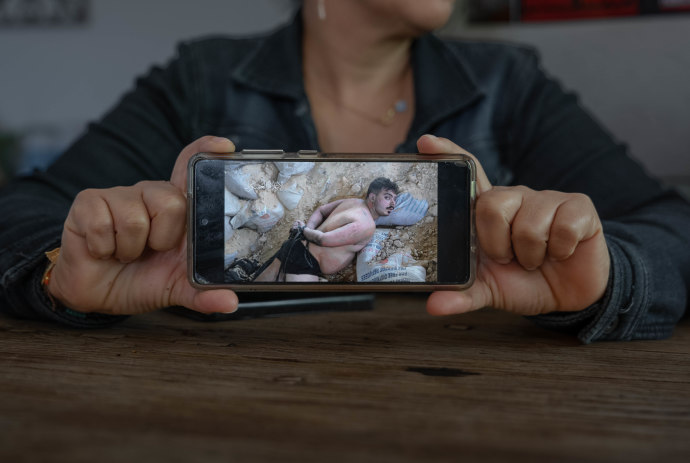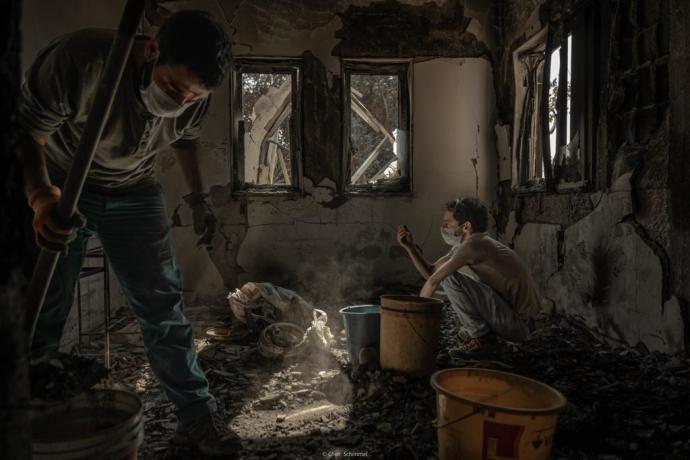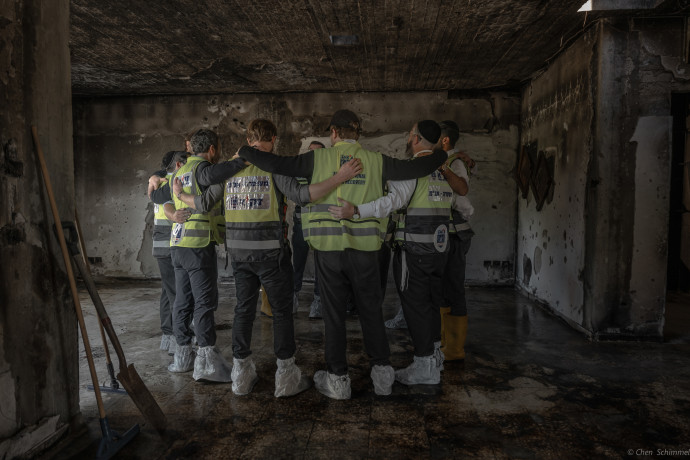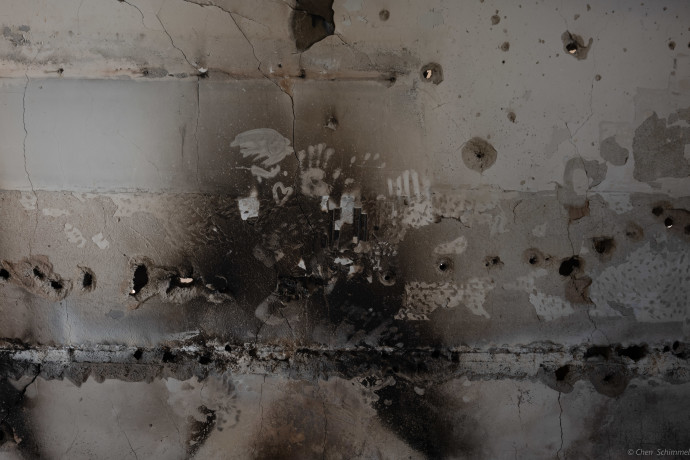Chen Schimmel makes her mark Young photographer’s Oct. 7 exhibition shown at Jpost Berlin Conference
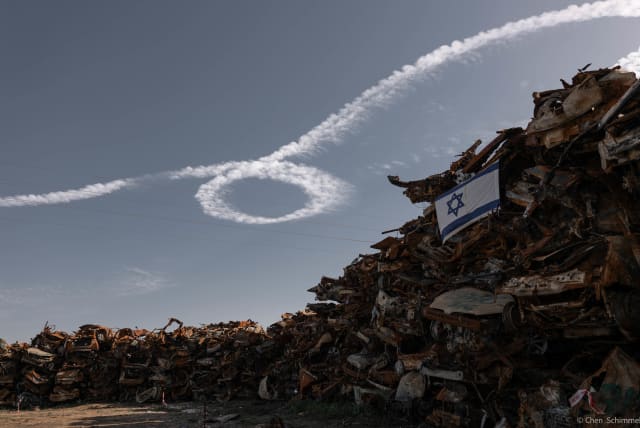
The photo exhibition, titled “October 7,” captured the aftermath of terror, offering an unflinching look at the human cost of violence.
Chen G. Schimmel recalls the moment that photography became her passion. Touring the picturesque alleys of Morocco when she was 16, Schimmel encountered a hooded man with his hand stretched out as if begging.
“We walked past him,” she says, “and then I genuinely remember stopping and saying ‘There’s no way I can miss that. I need to go back.’ So I went back and took the photo, which just stuck with me. It’s not a particularly good photo, but just the moment, and freezing it in time – I was very drawn to that.”
Born in London, the now 24-year-old Schimmel made aliyah in 2017 with her parents and younger brother (her three older brothers were already living in Israel).
“My whole life, I wanted to live in Israel,” she says.
Schimmel owes her strong Zionist feelings to her parents. Her mother had originally moved to Israel from Zurich on her own at age 16. Later, “My grandparents made aliyah at the age of 80, and we followed,” Schimmel explains.After she made aliyah, Schimmel joined an army mechina (preparatory) program and then served in the IDF international relations unit. Upon completing her army service, she spent time traveling and volunteering before deciding to indulge her full-time passion for photography.
Kevin Carter’s 1993 Pulitzer Prize-winning photograph, “The Vulture and the Little Girl,” depicting a starving child with a vulture in the background, inspired her to pursue a career in photojournalism, to tell stories through photographs that would have otherwise remain untold.
“I want to tell a story through my photos that leaves a mark,” she explains.
Her Leica camera is always with her, enabling her to take photos whenever something catches her eye. “The camera is like the extension of my arm,” she says. “When I take a photo, I don’t think that I’m here to tell a story – I’m just capturing the moment.”
Until Oct. 7, most of Schimmel’s shots were street scenes, portraits of people, and exotic animals she encountered on a visit to Antarctica. She considers famed candid photographer Henri Cartier Bresson (1908-2004) to be the “master of masters.”
After Israel was attacked on Oct. 7, Schimmel switched gears and began documenting the tragic events taking place. She has traveled to the Gaza border communities numerous times, snapping ZAKA teams recovering human remains from the Hamas massacres, photographing families of the Gaza hostages, and covering demonstrations, as well as the funerals of soldiers killed in action. Much of her recent work has been featured in The Jerusalem Post, and she is a freelance photographer for Flash90.
This past week, Schimmel was honored with an exhibition of a selection of her photos at the Post’s Joint Perspectives Conference held in Berlin in cooperation with the German newspaper Die Welt in the offices of leading German publisher Axel Springer. She was asked to select 15 of her most meaningful photos from the thousands she has taken over the past four months.
“I spent days going back and forth, trying to tell every aspect of what had been.”
The photo exhibition, titled “October 7,” captured the aftermath of terror, offering an unflinching look at the human cost of violence. “These images are a silent outcry against the desecration of life, each frame striving to honor the memory of those we’ve lost,” Schimmel says, emphasizing the contrast between the terrorists’ disregard for life and the reverence with which victims are remembered.
The Berlin exhibition opened with the photos titled Bearing Witness; Shattered Sanctuary; and Shadows of Be’eri, setting a tone of loss and resilience, revealing the scale of destruction and of innocence lost amid the violence.Schimmel’s lens captures the transformation of Be’eri from a tranquil, rural kibbutz to a landscape marred by violence.
“My photographs seek to memorialize the sanctity of the lives brutally cut short, highlighting the dignity with which our community responds to such unfathomable loss,” she explains.
The exhibition delved deeply into the narratives of destruction and mourning, capturing scenes of devastation that resonate with the solemnity of loss and with the solemn dignity accorded the departed.
The exhibited works Innocence Lost; Holy Work; The First Rain; and Resilience in Harmony focus on ZAKA’s vital efforts in the midst of tragedy. From the heart-wrenching image of a child’s blood-stained toy to the solemn dedication of volunteers honoring the departed, these images highlight the sanctity of life and the community’s resilience. First Rain reveals the enduring scars of tragedy, while Resilience in Harmony captures a moment of unity and hope among volunteers, illustrating how humanity persists in honoring life amid darkness.
Through ZAKA’s work, Schimmel witnessed firsthand the profound commitment to honoring the deceased, meticulously collecting every remnant, and ensuring they receive a dignified burial.
“Witnessing ZAKA’s dedication was a deeply moving experience, reinforcing the profound disparity between the sanctity we afford to life and its cruel desecration by terrorists,” she says.
She cites a visit to Be’eri, where ZAKA members returned 70 days after Oct. 7. The first rains had washed away the ashes, revealing a floor covered in blood. “While they were on their hands and knees, scraping the blood and doing the holy work that they do, they were singing “Ani Ma’amin” [“I believe”] at the top of their lungs.”
The exhibition presented a compelling trio of untitled photographs, each a silent yet eloquent testament to the enduring agony and anticipation of families affected by the hostage crisis. These images resonate with unspoken narratives of waiting, hope, and endurance of the absence of loved ones.
The exhibition pays tribute to the sacrifices of soldiers with the photo First Funeral, marking the solemn farewell to Corp. Nathanel Young, the first soldier laid to rest after Oct. 7; and Brothers in Arms, honoring the Slotki brothers’ unity and sacrifice. Interrupted Farewell captures a funeral disrupted by rocket sirens, a reminder of the conflict’s immediacy and the fragile line between life and death.
The narrative concluded with Where Are You? – a portrayal of families of the hostages standing together, imploring for intervention and justice, their placards and pictures a powerful testament to their plight. Their collective plea for action underscores the urgent need for global attention and a unified effort to bring their loved ones home.
Schimmel says that she snapped her most meaningful photo in the home of the Haran family of Kibbutz Be’eri, where the father had been murdered and seven family members taken hostage. Six were freed, but one remains in Gaza. Schimmel took a picture of the family searching among the debris of their home and finding a hanukkiah in the rubble.
She says she is asked how she copes with the emotional stress of photographing so many tragic events and scenes. Her response is “Speaking to the hostage families and to speak to the people that are going through absolute hell is what gives me strength. It’s their strength in those moments that just lifts me out of it. And that’s how I keep going.”
For any photographer, having their photos displayed to the public is a great honor, and Schimmel was particularly moved that hers were chosen for the exhibition. Enlarged versions of the pictures were printed in Berlin, and she was overwhelmed when she saw them life-sized.
“I cried,” she says, “because I’d never seen them like that. To go from taking those photos, which in themselves are difficult and emotionally provoking, to actually seeing them here and in Germany – in Berlin – was very moving for me.”
Schimmel says she received positive comments from the conference attendees who visited her exhibition. “A lot of the feedback was from people coming up to me and saying, ‘This is weird to say, and it’s hard to say, but these photos are beautiful.’ For me, to capture a moment that’s filled with such anguish and pain and to still call it beautiful – to me, that is what I really aim to do.”
She uses only natural light in her photos, and says that they have a dark, moody feel to them.
Even an experienced photographer such as Schimmel gets nervous before she begins a shoot.
“Every time I take photos, I get nervous,” she confesses. “But [feeling] the nerves is what actually gives me the drive, what makes me feel that I’m in my element – what makes me feel the most alive, and from that, I grow every single time I take photos. I think the day the nerves stop, then maybe I should be concerned.”What’s next?
Schimmel would like to take pictures of the remaining hostage families, after which she has another project in mind.
“I’m very drawn towards the hope and the resilience of, perhaps, the soldiers. I was thinking of also doing the unsung heroes – the women whose husbands are in miluim [army reserves] and women who are pregnant whose husbands [have fallen]. I’m really thinking of doing something about that. It’s a lot of constantly thinking about what more I can do.”
For Schimmel, success is defined as taking a photo that will make an impact.
“If someone sees a photo of mine and some sort of emotion is stirred up inside, or it leaves a mark and it’s
something they don’t forget – that for me is a success.”
Photos: CHEN SCHIMMEL
Jerusalem Post Store
`; document.getElementById("linkPremium").innerHTML = cont; var divWithLink = document.getElementById("premium-link"); if (divWithLink !== null && divWithLink !== 'undefined') { divWithLink.style.border = "solid 1px #cb0f3e"; divWithLink.style.textAlign = "center"; divWithLink.style.marginBottom = "15px"; divWithLink.style.marginTop = "15px"; divWithLink.style.width = "100%"; divWithLink.style.backgroundColor = "#122952"; divWithLink.style.color = "#ffffff"; divWithLink.style.lineHeight = "1.5"; } } (function (v, i) { });


